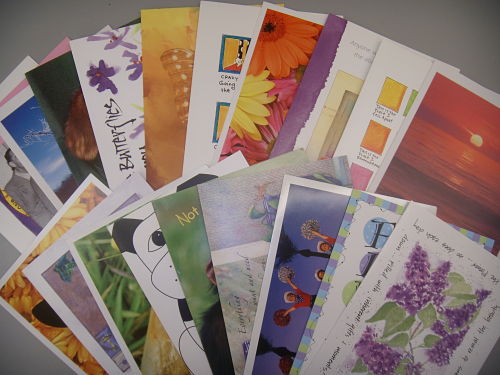By Carolyn Edlund
Part 1 of this series gave some basics for artists who want to start a greeting card line. Part 2 continues with more information about your line, and Part 3 will concern sales and marketing.
How big of a line do you need?
You need to create a cohesive body of work as a “collection” to attract attention and make more sales. Store owners have card displays which are often spinner racks, and you will want to have a rack devoted to your line, or a good presence on their existing displays. The minimum number of pockets on a standing card rack is 24. That is small for a line, but you must have at least this many designs. I suggest you create at least 48 cards to choose from, in proportionately the right categories (see Part 1 of this series).
You can have what is called a “pre-select”.
Many retailers don’t have time to pick individual cards, but will try a line if they find it appealing. You choose your bestsellers, in balanced categories (birthday, get well, etc.) to offer as a package deal. Having a display or rack that comes with it is a definite plus, but you should offer the starter package with and without a display. Check out Snafu to see a card line that offers bestseller packages.
Where do you find display racks?
Check online for display manufacturers, such as Displays2Go and find some different sized display racks you want to offer. Racks come in wire and also plastic, in a wide range of prices (wire is the cheapest). You can charge your customer for a rack in your package price, (passing on the wholesale cost without markup is pretty standard), or you can offer a free rack as an incentive. Racks should be drop-shipped to the customer from the manufacturer.
What size should your cards be?
The standard size for a greeting card is 5”x7”. I suggest using this size format for two reasons: first, they will fit nicely into standard pockets on existing card racks. Secondly, you can pop the 5”x7” card of your artwork right into a standard 8”x10” mat and frame it, thus making it into framed art for sale! Pretty cool, huh?
What size should your cards NOT be?
In general, stay away from square cards and oversized cards. Although companies like Quotables have done well with squares, the post office charges extra postage for them as they are not machinable. Oversized cards are extra postage, too. Keep in mind that 60% of greeting cards purchased are mailed. And that paying extra to mail a card is very, very annoying.
Indicator Cards.
Also called “Caption Cards”, these are single pieces of cardstock which sit behind the cards in each pocket and are about ½” higher. They say “BIRTHDAY” or “BLANK”, etc to show the sentiment of the title in that pocket. The Indicator can show the sentiment either above the cards, or can be folded twice to sit below the cards in a clear plastic or wire pocket. Go to a card store and see how these work. These are essential to have, and proper indicators must be included with every pack of six cards and envelopes that you ship. Cards sitting in display pockets without indicators do not sell. This is the kiss of death for sales, so I can’t stress it enough.
Define your market.
Who are your customers? Baby Boomers? Students? Men? Christians? Actually, 80% of cards are purchased by women, and the largest group of card-buying women is middle-aged. Decide who you are trying to reach, and create a line for them. You can’t be everything to everybody.
You are not Hallmark.
They have a vast number of products, lines and titles. They can afford to have a card saying “To My Sister-in-Law on the Death of Her Pet”, even though a sentiment like this would have a very small market. Stick to the basics. There are categories which are slow, and I would suggest avoiding in your line, such as: Retirement, Good Luck, I’m Sorry, Pet Sympathy, Graduation, Baby Shower, Engagement, Divorce, New Home, and birthday cards to a relative such as Husband, Son, Niece, etc.
This is the second article in a series. See the other articles here:
What You Didn’t Know About Starting a Greeting Card Line (Part 1)
What You Didn’t Know About Starting a Greeting Card Line (Part 3)
Author Carolyn Edlund is the founder of Artsy Shark and a business consultant for greeting card entrepreneurs. Need assistance to improve or grow sales of your own line? Find out more here.




Thanks so much for the wealth of insights! I’m so glad I stumbled upon your site. It’s a gold mine! Now to get to work!
You probably have no idea what a treasure chest of ideas you’ve provided us with. Thank u ever so much!